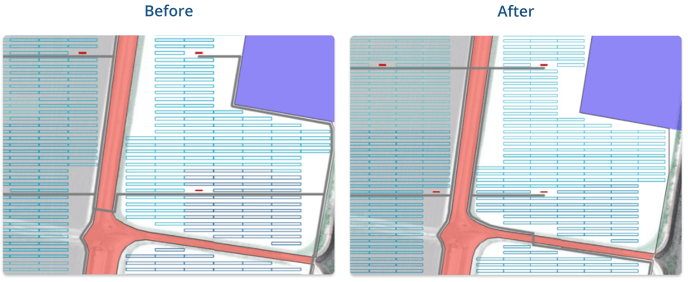Generate multiple designs, improved bill of quantities, road layout shortcuts
pvDesign - backend v5.1.70, frontend v1.2.3
In this release, a huge new feature was introduced, the ability to generate multiple designs using a range of values (pitch or DC/AC ratio). We believe this feature to be a great example of how pvDesign can speed up the process of finding the optimal design of a PV plant.
The updates in these two months also include many new features, improvements and bug fixes. We also separated the bill of quantities from the financial analysis. The new bill of quantities contains the interconnection facility results, which were previously unavailable.
We have also been working towards improving the user experience of pvDesign. We have made many small changes in the user interface, and also achieved a significant reduction in simulation time.
Finally, the road shortcuts feature will enable users to customize the layout to a degree that was not previously possible.
New Features
The following features were released:
- Generate multiple designs: It is now possible to generate up to 10 designs automatically. The designs will be generated by exploring different values of pitch distance or DC/AC ratio. The results can then be analyzed using the design comparison tool.
- New financial analysis documents: We have separated the financial analysis from the bill of quantities. The bill of quantities document now includes all the simulation results, and also includes the interconnection facility results. The financial analysis document includes the CAPEX estimation defined in the design process.
- Road layout with shortcuts: Tweak the road definition algorithm by manually creating roads. Create the roads in Google Earth, and save them in a specific folder. These roads are strictly for communicating parts of the PV plant, they will not be used to place power stations. This is useful to reduce the total length of roads by allowing pvDesign to place roads crossing restricted areas, for example. Find more information here.

- Specify cable sections: Select which cable sections pvDesign is allowed to use when sizing the electrical system. Each electrical level (string cables, string combiners to inverters, MV lines, etc) has its own selector.
- Regular blocks feature: We have implemented an improved version of the regular blocks feature. The new version will move the columns of blocks in between roads to improve the fit against the perimeter of the areas. This improvement is also applied in adaptive designs, further increasing the maximum peak power.
- User experience improvements: We have been making many small changes that improve the overall experience of using pvDesign. When uploading a meteorological or elevation data file, if an error occurs, details can now be found in the application. It is now possible to open the sidebar, project and design links in a new tab. The project page will now correctly reload the status of in-progress designs without needing to refresh the page.
- Design simulation time improvements: We made some big changes to how pvDesign simulates your designs. Now designs should finish faster than before. Firstly, we have upgraded the servers pvDesign uses to generate your designs. Secondly, we made several improvements to the pvDesign backend. Now it is possible to choose the languages in which the documentation is generated, allowing users to generate fewer languages, which results in a faster simulation. Thirdly, the code which generates the drawings was optimized, which was especially important for the bigger designs.
- Power factor energy yield simulation: We changed how the power factor is taken into account in the calculation methodology. Now the inverter will adjust its power factor without incurring a loss if the limit of apparent energy (kVa limit) allows it. For more information, check out the energy yield methodology.
Bug fixes and improvements
The following improvements and bug fixes were released:
- Updated translations in the user interface.
- Solved issues caused by illegal characters in the design name.
- Added user notes to the CAPEX templates.
- Increased the number of CAPEX templates shown in the templates page.
- Improved the algorithm for roads selection so that more exterior roads are kept in some conditions.
- Added a tolerance value of 1mm to the undulation tolerance filter, to avoid numerical precision issues.
- Fixed issue with the roads connecting areas.
- Tweaked the road algorithm configuration to improve the selection of which exterior roads to keep.
- Fixed the calculation of the number of fence gates for the BOQ.
- Fixed an issue in the calculation of cables which caused simulations to fail.
- Fixed an issue in the roads algorithm which caused simulations to fail if a restricted area entirely covered available areas.
- Fixed an issue in the fence algorithm which caused simulations to fail.
- Tweaked the power station positioning algorithm to correct errors.
- Fixed an issue with the document generation system which caused simulations to fail.
- Fixed an issue with the listing of cables document which caused simulations to fail when two available areas were duplicated and overlapped.
- Improved the KML import algorithm so that it doesn't accept KML files with available areas which are contained within one another.
- Disabled the automatic recommendation of the regular blocks mode for PV plants of more than 1000 ha.
- Fixed an issue that was causing the undulation tolerance filter not to work correctly for bi-pole fixed structures.
- Improved handling of an error that occurred when the DC power an inverter required was lower than the power of one structure.
- Fixed issue with the structure and block codes which were shown in the listing of posts and the topography analysis.
- Updated topography and earthworks translations.
- Improved the placement of roads in the PV plant. This should result in higher peak power for some geometries.
- Increased the potential positions for placing a power station, which should reduce simulation errors.
- Added new base parameters for the CAPEX estimation tool (peak power and rated power in different power units).
- Fixed an issue that caused the structures to be too close to the roads in some situations.
- Fixed some errors in the bill of quantities entries referred to the double busbar substation.
- Fixed an issue that caused structures to overlap roads in some conditions.
